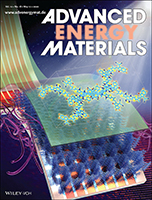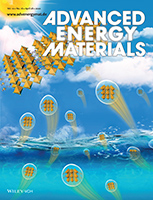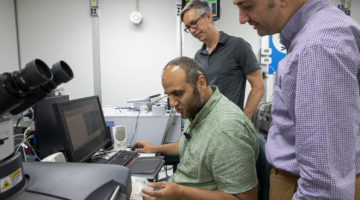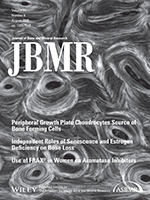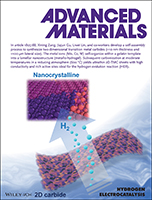Qinye Bao and co‐workers systematically investigate the energetics and energy loss in 2D Ruddlesden‐Popper perovskite (RPP) solar cells. The crucial scenario found at the 2D RPP/electron transport layer interface is that the potential gradient across ligands promotes separation of the photogenerated carrier, with electrons transferring from the perovskite crystal to the electron transport layer. Read more »
Efficient Organic Solar Cell with 16.88% Efficiency Enabled by Refined Acceptor Crystallization and Morphology with Improved Charge Transfer and Transport Properties
Feng Liu and co‐workers report a detailed structure‐performance relationship to help understand the success of Y6 non‐fullerene acceptors. Through the analysis of the single crystal structure of Y6, it is found that Y6 forms a polymer‐like conjugated backbone through its banana‐shaped structure and π‐π interactions between molecules, and forms a 2D electron transport network under the ordered arrangement of the lattice. Read more »
Coordination Engineering of Single-Crystal Precursor for Phase Control in Ruddlesden-Popper Perovskite Solar Cells
Chaochao Qin, Alex K.-Y. Jen, Kai Yao and co-workers describe a generic guideline for fine tuning colloidal properties of 2D perovskites via coordination engineering of the single-crystal precursor solution. In nonpolar co-solvent media, the derived colloidal templates prefer to grow along the vertical direction with a narrow phase variation, elucidating the critical role of colloidal chemistry in low-dimensional perovskite solar cells. Read more »
Freeze Frame: Scientists Capture Atomic-Scale Snapshots of Artificial Proteins
Protein-like molecules called polypeptoids have great promise as precision building blocks for creating a variety of designer nanomaterials. In this study, rsearchers used cryo-EM, a technique originally designed to image proteins in solution, as well as x-ray scattering techniques, to characterize the structure of polypeptide nanosheets. Read more »
Scientists Explore Egyptian Mummy Bones With X-Rays and Infrared Light to Gain New Insight on Ancient Life
Researchers from Cairo University worked with teams at the ALS to study soil and bone samples dating back 4,000 years. The experiments are casting a new light on Egyptian soil and ancient mummified bone samples that could provide a richer understanding of daily life and environmental conditions thousands of years ago. Read more »
Go With the Flow: Scientists Design Better Batteries for a Renewable Energy Grid
Researchers developed a versatile yet affordable battery membrane—from a class of polymers known as AquaPIMs. This class of polymers makes long-lasting and low-cost grid batteries possible based solely on readily available materials such as zinc, iron, and water. Read more »
Linking Structure to Behavior in Twisted Liquid Crystals
Researchers untangled connections between structure and behavior in a class of liquid crystals consisting of flexible, chain-like molecules that self-organize into twisting patterns. The study opens up new possibilities for designing novel liquid-crystal molecules that allow greater control of nanoscale behavior for technological applications. Read more »![]()
![]()
Mechanical Competence and Bone Quality Develop During Skeletal Growth
Researchers explored how bone quality and mechanical competence progress during longitudinal bone growth. Deformation at the tissue, fibril, and mineral length scales was investigated with mechanical tensile tests during small and wide-angle x-ray scattering/diffraction (SAXS/WAXD) experiments, revealing dramatic differences in mechanical resistance with age. Read more »
Conductive triethylene glycol monomethyl ether substituted polythiophenes with high stability in the doped state
Researchers synthesized and characterized two iodine-doped polymers with high conductivity and stability. The doping increases the transparency of thin films of the polymer, which are resistant to common organic solvents. All these properties indicate great potential for the polymers to be used in applications such as organic field effect transistors, organic photovoltaic devices, and sensors. Read more »
Self‐Assembly of Large‐Area 2D Polycrystalline Transition Metal Carbides for Hydrogen Electrocatalysis
Xining Zang et al. develop a self‐assembly process to synthesize 2D transition metal carbides (TMCs). The metal ions (Mo, Co, W) self‐organize within a gelatin template into a lamellar nanostructure. Subsequent carbonization at moderate temperatures in a reducing atmosphere yields ultrathin 2D‐TMC sheets with high conductivity and rich active sites ideal for the hydrogen evolution reaction. Read more »

